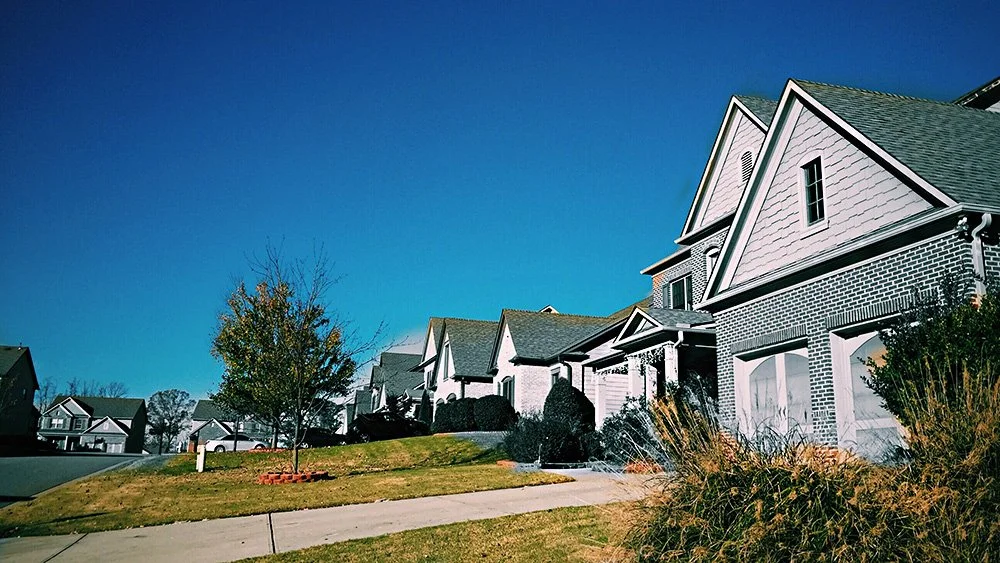The End of Suburbia Starts With Disobedience
The Katy Freeway in Houston.
Strong Towns is full of bad news about the long-term prospects of suburban places—and our formerly urban places that have been bulldozed to resemble them. The Ponzi-scheme nature of these places means that the slow decline of American suburbs is likely to continue far into the future. The other promise of Strong Towns, however, is that recovery is possible. What will the end of the suburbs look like? What are those first signs of life that indicate a recovery? I’d like to show you what that might look like, in all its strangeness.
I’ll examine my own place, Houston, which is often cited by urban-planner-type people as the picture-perfect postcard of car dependence. Pictures of the Katy Freeway (pictured left) often make the rounds on Reddit. Take it from a native: this place has real problems. I humbly ask that you reserve judgment and approach this piece with an open mind. You may learn something along the way.
The first thing you need to know about Houston is that it is incredibly segregated. Until 1948, that segregation was explicitly enforced through racial covenants, and since the 1950s it has been perpetuated through urban design. Neighborhoods were strictly separated by race and income, and working-class people—which inevitably means Black urbanites in the South—were confined mostly to the urban core and east side of town. The second thing you need to know is that Houston is incredibly diverse. As an immigration destination and international energy industry hub, it consistently ranks near the top of U.S. cities and rivals New York City in diversity of cultures and incomes. Its citizens are dynamic and creative, each one hungry for the opportunity to improve their condition.
For decades, Houston's tightly bound spatial segregation was maintained by single-family deed restrictions (which is called R-1 zoning in other cities), minimum lot sizes, and setbacks, which kept exclusive neighborhoods inaccessible to those with lower incomes, and by highway boundaries which separated the well-to-do from poorer areas. In the present day, these stark lines have begun to blur in startling fashion. Not only are Houstonians poorer overall, outside of a few wealthy (mostly white) enclaves, they are more evenly mixed than during the illusion of wealth phase of the Suburban Experiment. Because these suburban neighborhoods are financially unproductive, their infrastructure has decayed rapidly. Rich residents moved even further out, leaving only the desperate behind:
Houston Income Diversity in 1980 vs. 2010
A Map of Houston with Downtown shown as a black dot in the middle. (Source: Rice University Kinder Institute for Urban Research.)
What has happened in the aftermath, however, may surprise you. In order to explain, I first need to bore you with legalese. Houston famously never adopted zoning, which are laws commonly used in North America to specify what should be built where. Instead, it makes pervasive use of something called deed restrictions. These are restrictions on individual lots that can perform the exact same functions as zoning by restricting use, setting minimum lot size, setbacks, etc. Almost every postwar neighborhood in Houston was built to be a single-use monoculture like anywhere else in North America, with deed restrictions to match. Pre-war neighborhoods adopted similar deed restrictions with non-conforming lots grandfathered in. The key difference is that deed restrictions apply lot by lot as opposed to entire neighborhoods, and the city tends to only enforce them if a neighbor complains. Today, slowly but surely, those restrictions are being allowed to expire or are practically unenforced.
Deed restrictions essentially rely on local consensus to function—and that consensus is waning. The old homeowners’ associations that enforced the deed restrictions have withered for lack of members, lack of interest, or for myriad reasons. Quietly, the monoculture of detached houses are being allowed to turn into de-facto duplexes, home offices, places of worship, and small businesses. Need a home office? Set up a desk in the garage. Need a restaurant? Take out some interior walls and add a ramp. Need more housing? Add a few roommates. These houses are slowly being adapted, added onto, and changing use as part of a more flexible, stronger urban fabric. While many home businesses are indistinguishable from the outside, here are a few more visible examples:
A house in the Rice Village has been expanded out to hug the sidewalk.
A house along University Blvd is now a two-story storefront.
This is how the Suburban Experiment really ends: not with explosive legislation, but with regular people making the best of what they have. In Houston, what we have is houses. I propose that these new house-businesses, home offices, and de-facto multifamily residences are the first increment of intensity for a suburban neighborhood. Often these businesses aren’t even marked, and the only evidence that they exist is a website and an address on Google Maps. They’re messy, they’re a bit ugly, they definitely don't look like a city, but they’re functional. They’re so widespread you can find them in all but the wealthiest neighborhoods, eking out a living on the edges or in the middle of unassuming blocks. The property may change hands from one business owner to the next. As the neighbors get used to the idea of living next to a business, the houses get built out, becoming incrementally more intense. Need more space? Turn a lawn into a dining porch. Need a bigger interior? Expand out to the sidewalk. Need another room? Turn a garage into an apartment. Given the right conditions, that traditional, walkable urban fabric emerges and thickens up—no zoning required.
Remember that these developments are technically illegal. They got there because the owners are conveniently unaware of their own deed restrictions, their neighbors conveniently look the other way, and the city typically has bigger problems. These neighborhood commercial buildings then get passed from owner to owner. A fine example of Texans’ famous independent streak in action. As a result of this quiet development, headlines like these are becoming a somewhat common occurrence in the Houston Chronicle:
Houstonians have been quietly building out their own neighborhoods in defiance of archaic rules that no longer serve them. The city, on the odd occasion they are called to enforce a deed restriction, are getting stuck in legal swamps. A municipality deep in decline, facing decaying infrastructure and accelerating poverty can hardly afford lengthy legal battles. Restoring the original monocultures would almost certainly be more trouble than it's worth. In a city famous for its dysfunction, developments like these are refreshing news.
Against all prediction or planning, a dense and flexible urban form can re-evolve out of the suburban monoculture. Artificial monocultures are just that: artificial. Houston’s municipal government, spread thin over 600+ square miles and $19.6 billion in debt, is in no place to continue to enforce unnatural uniformity. As slow as molasses and as inevitable as gravity, the seeds of incremental development are growing again in Houston.
How does this dynamic apply to other places; perhaps to your own place? The reader may say that cities with strict zoning are different. Those restrictions apply to huge zones and are enforced by force of law, not by neighborhood consensus. However, I can imagine a similar dynamic playing out in countless other places deep in suburban decline. A city government spread too thin to effectively enforce its own use restrictions, neighbors apathetic to the aesthetics of suburbia, and entrepreneurs eager to make a living are the ingredients. If these conditions remind you of your own place, how might you make use of them?
In writing this conclusion, I find myself on difficult ground. I will stress again that developments contravening zoning rules or deed restrictions are illegal. They are, at best, an act of civil disobedience: citizens and communities flexing their agency within cities too feeble to continue suppressing development pressures. At worst, they could spark inquiries resulting in legal or financial consequences for those challenging the law. There is, however, a prescient example we could examine.
Businesses in houses along Westheimer have been replaced with a denser, more flexible, urban-style building.
Montrose, a former streetcar suburb in West Houston, has largely allowed its deed restrictions to expire completely. This means that outside of a few holdout pockets, new mixed-use and incremental developments are 100% legal. To be sure, Montrose started with a few advantages—a street grid, relatively small lots, and relatively narrow streets—but it endures plenty of typical disadvantages as well, such as parking minimums. You can still see the remnants of those days when it was mostly houses and apartments like any other pre-war suburb. Today it is a thriving incremental neighborhood reintroducing that strong urban fabric visible in so many other great cities. Freedom, not more rules, is the key ingredient that makes this progress possible. Even with the baggage of narrow sidewalks and terrible public transit, without form-based codes or subsidies, the same economic forces that shaped the cities of the past are slowly causing a walkable built form to evolve in Montrose. Starting from the smallest opportunities, Houston is being rebuilt incrementally up and incrementally out.
The lesson for the reader here is clear: if the Suburban Experiment no longer serves you or your community, let the people build.
Robert Rice is a designer from Houston, Texas, currently working in New York City. Passionate about our built environment and how it affects American society, he holds a bachelors in architecture from Carnegie Mellon University with a background in sustainable design. He is an avid hiker, an eager observer of urban environments, and an amateur writer.












